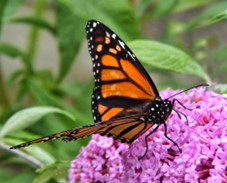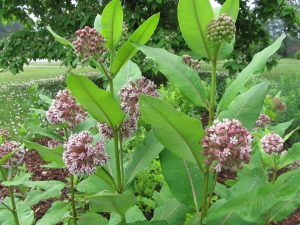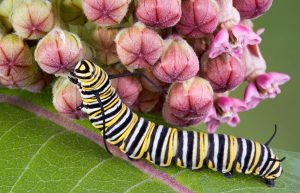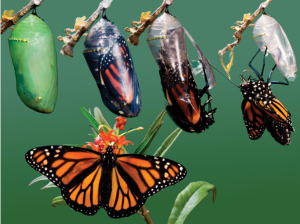By David Wasmuth
One of the most remarkable migrations ever documented is about to begin. And, for some migrants, it may start in your backyard.
By late September, millions of monarchs, those distinctively beautiful orange-and-black butterflies that have been fluttering through New Jersey parks and gardens since early summer, will head south to overwinter in a Michoacan, Mexico, forest.  For a local monarch, that means a journey of over 2,000 miles, completed in segments of around 50-100 miles a day. The monarchs’ arrival in Mexico will roughly correspond to early November’s Day of the Dead celebrations; some Mexican traditions associate the returning butterflies with the returning souls of departed loved ones.
For a local monarch, that means a journey of over 2,000 miles, completed in segments of around 50-100 miles a day. The monarchs’ arrival in Mexico will roughly correspond to early November’s Day of the Dead celebrations; some Mexican traditions associate the returning butterflies with the returning souls of departed loved ones.
Apart from the rigors of the journey – butterflies flapping their fragile wings across hundreds of miles in often inclement weather – there remain mysteries about the migration. What triggers them to start? Why do millions of monarchs from across eastern North America congregate in less than eight square miles of central Mexican forest – sometimes staying on the exact same trees where their distant ancestors overwintered? And how do they know where to go and how to get there? After all, the returning monarchs are several generations removed from the last of their ancestors to make the trip. The fall migrating monarchs are exceptional. While typical adult monarchs survive for about a month, these, the so-called Methuselah generation, will live for around eight months. After their arduous trip south, the Methuselah monarchs will spend the winter in semi-dormancy clustered tightly together on trees: so tightly that there can be up to 15,000 on a single branch. And it’s not just any tree. They use only a specific species, the oyamel, rare even in its limited Mexican range. North Americans may associate Mexican winters with sunny beach vacations, but the oyamel forest is nearly two miles above sea level with often freezing temperatures and occasional snowfall.
In still-cold early March, some sort of internal alarm clock triggers the dormant monarchs. The whole colony awakens. They mate and begin the return journey north. The trip north, however, will be a relatively short one for the monarch’s Greatest Generation; even Methusaleh eventually passed away. Reaching northern Mexico or Texas, they will find milkweed, lay their eggs on it, and, at last, die.
From this point on, the key to monarch survival is milkweed. It is the species’ only host plant, the only plant their caterpillars can eat. And eat it they do; once hatched, monarch caterpillars dedicate their lives to eating milkweed and getting bigger.  Biologist David George Haskell estimates that if a human baby gained weight at the same rate as a caterpillar, she would weigh nine tons by adulthood. That would be an awful lot of baby formula, and on the caterpillar scale its an immense amount of milkweed. But milkweed offers more than just nutrition. It contains toxins making its leaves unpalatable to all but a few insects. Those ingested toxins make the monarch caterpillar and the butterfly it will eventually become unappetizing to birds and other vertebrate predators. The brilliant color of the adult monarch and the distinctive yellow-white-black stripe pattern of the caterpillar warn these predators that this is not a desirable meal.
Biologist David George Haskell estimates that if a human baby gained weight at the same rate as a caterpillar, she would weigh nine tons by adulthood. That would be an awful lot of baby formula, and on the caterpillar scale its an immense amount of milkweed. But milkweed offers more than just nutrition. It contains toxins making its leaves unpalatable to all but a few insects. Those ingested toxins make the monarch caterpillar and the butterfly it will eventually become unappetizing to birds and other vertebrate predators. The brilliant color of the adult monarch and the distinctive yellow-white-black stripe pattern of the caterpillar warn these predators that this is not a desirable meal.
While repellent to birds, milkweed toxins are of no use against spiders or insect predators, and the monarch caterpillar’s life is perilous. Under 10% will survive the roughly 18 days it takes to go from hatchling to chrysalis. The eight to fifteen days spent in the chrysalis stage then produce an astonishing transformation. The cute but humble crawling caterpillar that went into chrysalis will emerge as the flamboyantly colored flying adult we recognize as a monarch. The adult monarch will feed on nectar from a wide variety of flowering plants in addition to milkweed, but it will lay its eggs only on milkweed. 
The cycle will repeat itself over the spring and summer as generations of monarchs continue the process of migrating north, finding milkweed, laying their eggs, and leaving it to the next generation to continue the northward trek. They typically reach northern New Jersey by early summer. It takes around four generations to reach as far north as Quebec. Then, by early autumn, a new Methusaleh generation is born to start the journey back to Mexico.
Unfortunately, all is not well in monarch world. Candidates for the Endangered Species List, they are vulnerable at several points in their life cycle. Illegal logging in their winter Mexican range has had an impact, and small area of this range means local weather events, such as freezing rain, can have a severe impact on the population. Climate change makes extreme weather more likely; a fire would be disastrous.
 Their dependence on milkweed also makes monarchs vulnerable. Once common in and around farm fields from Texas to the Northeast, milkweed has become scarce with massive agricultural herbicide spraying. Insecticides aimed at agricultural pests are also fatal to monarch butterflies.
Their dependence on milkweed also makes monarchs vulnerable. Once common in and around farm fields from Texas to the Northeast, milkweed has become scarce with massive agricultural herbicide spraying. Insecticides aimed at agricultural pests are also fatal to monarch butterflies.
The challenges are not limited to agriculture. Spraying for mosquitoes, an increasingly common practice in Montclair yards, kills a very small proportion of fast-reproducing mosquitoes but has devastating effects on slower reproducing monarchs and other beneficial insects. And the suburban obsession with tidy sterile lawns leaves little habitat for monarchs or other pollinators.
Fortunately, there is much you can do in your own backyard to help. First, do no harm: avoid insecticide use. Definitely do not spray for mosquitoes and do not believe it when spraying companies tell you this controls mosquitoes effectively or is harmless to beneficial insects. Second – plant milkweed! Varieties such as butterfly milkweed and rosy milkweed make beautiful, long-blooming additions to your garden while supporting monarchs. Finally, plant fall-blooming native plants, such as goldenrods and asters. Those Methusaleh monarchs have a long, hard journey ahead of them and need nectar-rich plants for refueling stops.
Monarchs have been making their spectacular migration since at least the end of the ice age; no other insect does anything comparable, and certainly not with the monarch’s charismatic appeal. Let’s do what we can to make sure this unique phenomenon continues far into the future.
Support the environmental work of the Northeast Earth Coalition:
Interested in registering your yard with the Northeast Pollinator Pathway Project? Click on the butterfly!


